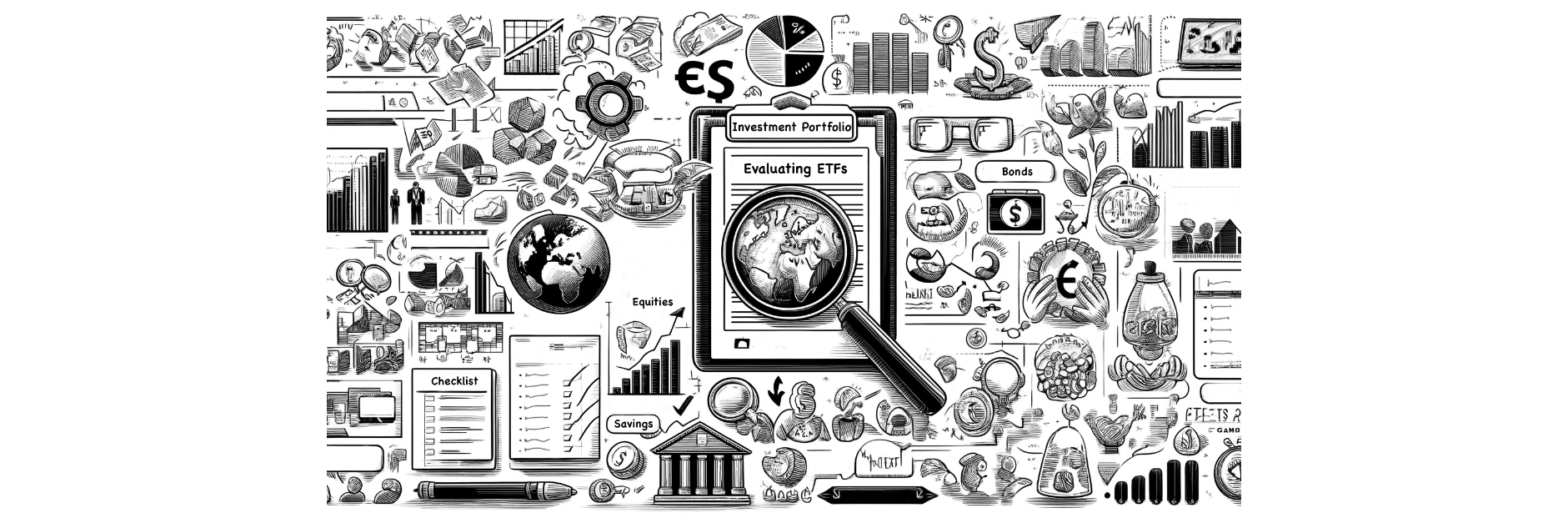How to Evaluate ETFs When Constructing an Investment Portfolio
Last weekend, I met a few of my close friends for an afternoon walk in the park. During the walk, one of my close friends asked me about how I picked the ETFs used to construct my investment portfolio. When it comes to building a solid investment portfolio, Exchange-Traded Funds (ETFs) can be an excellent option due to their diversification, cost-effectiveness, and flexibility. During our conversation, I shared how I looked at the different pieces of information of an ETF to evaluate if it is suitable for me.
Here’s a step-by-step guide on how to evaluate ETFs to ensure they align with your investment goals, with a specific focus on the needs of Singaporean investors.
Every week, I’ll be sharing practical tips and invaluable knowledge to guide you on your path to financial independence.
Have a clear understanding of your investment goals and market opinions
Before diving into the specifics of ETF selection, it’s crucial to define your investment goals. Are you looking for long-term growth, income, or capital preservation? Understanding your goals will help narrow down the type of ETFs that are suitable for your portfolio. At the same time, you should form your own perspective of the industries and geographical regions that you believe, will do well in the long term. For some, it could be industries that you have work experience in, where you have in-depth knowledge about. For others, it could simply be geographical regions that you believe will outperform based on data.
Your view on the market performance of different geographical regions can significantly influence your ETF selection. If you are bullish on the US market, you might opt for more US-focused ETFs. Conversely, if you believe emerging markets will outperform, you might increase your allocation to ETFs focusing on those regions. Diversifying geographically can also help mitigate risks associated with economic downturns in specific regions.
When I was constructing my investment portfolio, I was of the opinion that both European and Asian emerging markets will not do perform well in the long run. This was based on what I saw and the people I’ve interacted with in my career and during my travels. At the same time, I felt that there may be a chance that China may turn around and generate massive growth.
You may not be able to find the ideal ETF based on your investment beliefs. But it’s important to know what are our non-negotiables and what are the items that we are willing to compromise with. Below was what I landed with in 2022.
|
What I want in my portfolio |
What I am okay to keep in my portfolio |
What I don’t want in my portfolio |
|---|---|---|
|
|
|
After having clarity about what I want and don’t want, I was able to evaluate and conclude that popular ETF recommendations like FTSE All-World UCITS ETF USD Acc (VWRA) wasn’t suitable for my investment portfolio.
There are many types of ETFs in the market but we only need a few of them
ETFs come in various forms and each of them caters to different investment strategies.
Here are some of the types of ETFs available in the market today:
- Equity ETFs: Invest in stocks and can be broad-market (e.g., S&P 500) or sector-specific (e.g., technology or healthcare).
- Bond ETFs: Invest in fixed-income securities and are ideal for those seeking regular income.
- Commodity ETFs: Invest in physical commodities like gold, oil, or agricultural products.
- Thematic ETFs: Focus on specific themes or trends, such as clean energy or artificial intelligence.
In my opinion, the average investors simply need to have equity and bond ETFs in their portfolio and only after we have a sizeable portfolio, should the average investor need to think about investing in other types of ETFs like commodity and thematic ETFs.
ETFs also exist in physical and synthetic forms. Physical ETFs hold the actual securities that make up the index they track, providing direct exposure to the underlying assets. In contrast, synthetic ETFs use financial derivatives like swaps to mimic the index’s performance, without owning the physical securities. This can lead to different risk profiles, with synthetic ETFs potentially having counterparty risk due to their reliance on derivatives.
To keep things simple, I chose to invest in physical index ETFs that track broad-market index when constructing my portfolio.
Keep expense ratio low so that they do not eat into your returns
The expense ratio is the annual fee that investment funds or ETFs charge their shareholders. It is expressed as a percentage of the fund’s average assets under management (AUM) and covers the fund’s operating expenses, including management fees, administrative fees, and other costs associated with running the fund. Lower expense ratios are generally better, as high fees can erode your returns over time. My ideal expense ratio for ETFs is typically below 0.50%.
Components of the expense ratio:
- Management Fees: These fees are paid to the fund manager for their expertise in managing the fund’s investments.
- Administrative Fees: These fees cover the costs of record-keeping, customer service, and other administrative tasks.
- Operational Costs: These include expenses related to compliance, legal services, accounting, and auditing.
For example, if an ETF has an expense ratio of 0.50%, it means that for every $1,000 invested, $5 per year will be deducted to cover the fund’s expenses.
Why we want to keep expense ratio low
- Cost Efficiency: Lower expense ratios are generally better because high fees can erode returns over time.
- Performance Impact: The expense ratio directly impacts the net returns to investors. A high expense ratio can significantly reduce the overall return of the investment.
Think of it this way. When we manage our personal finances, we want to keep our expenses low so that we can save more money from our income. For investments, we want to keep the expense ratio low so that the expenses do not eat into the investment returns.
How should we evaluate the performance of the ETF?
Past performance is not indicative of future results, but it provides insight into how the ETF has managed market ups and downs. Look at the ETF’s performance over various time frames (1-year, 5-year, and 10-year) and compare it with its benchmark index.
Our goal should not to be to pick ETFs that are simply performing well on an uptrend. Our aim is to ensure that the ETFs that we have shortlisted, have consistently performed close to or above their benchmark (the index that they are supposed to be tracking).
We should also aim to select ETFs with a low tracking error as it measures how closely an ETF follows its benchmark index. A low tracking error indicates that the ETF accurately replicates the performance of its index. Ideally, tracking errors should be below 0.50% for equity ETFs and below 1% for bond ETFs.
Should we care about ETF liquidity?
Liquidity refers to how easily you can buy or sell an ETF without affecting its price. Highly liquid ETFs have tight bid-ask spreads and high average daily trading volumes. For Singaporean investors, look for ETFs listed on well-established exchanges like the SGX, NYSE, or LSE, and check that they have sufficient trading volume to avoid high transaction costs.
Based on online research, here are some ideal liquidity criteria you can consider when assessing the liquidity of an ETF:
- Average Daily Trading Volume: Ideally, look for ETFs with an average daily trading volume of at least 100,000 shares. This ensures there is enough market activity to buy or sell shares without significant price changes.
- Bid-Ask Spread: A tight bid-ask spread, ideally less than 0.10%, indicates good liquidity. Wider spreads can increase transaction costs.
- Assets Under Management (AUM): ETFs with higher AUM (e.g., over $100 million) tend to be more liquid, providing stability and ease of trading.
Understand the tax implications for Singaporean investors
Singaporean investors benefit from a favorable tax environment for investments. However, tax implications can vary depending on the domicile of the ETF. For my portfolio, I chose to invest in Ireland-domiciled ETFs which are typically listed on the London Stock Exchange.
Dividend Withholding Tax
- U.S.-domiciled ETFs: Dividends are subject to a 30% withholding tax, which can be reduced to 15% due to tax treaties between the U.S. and Singapore.
- Ireland-domiciled ETFs: Dividends from U.S. stocks held by these ETFs are subject to a 15% withholding tax. There is no additional withholding tax on dividends for Singaporean investors.
- Singapore-domiciled ETFs: There is no withholding tax on dividends.
Estate Tax
- U.S.-domiciled ETFs: The U.S. imposes an estate tax on assets over $60,000 owned by non-residents. This could impact legacy planning, as your loved ones may face substantial taxes when liquidating your U.S.-based portfolio.
- Ireland-domiciled ETFs: No estate tax issues for non-Irish residents.
- Singapore-domiciled ETFs: No estate tax.
Decide on your dividend preferences
Decide whether you want ETFs that pay out dividends or those that reinvest them. If you’re seeking regular income, go for ETFs with high dividend yields. However, if you prefer growth, look for ETFs that reinvest dividends, as this can compound your returns over time.’
The keywords you want to look for when evaluating ETFs is ‘accumulating’ and ‘distributing’.
If you want to reinvest all the dividends you receive from the ETF automatically, opt for an accumulating ETF like Vanguard FTSE All-World ETF USD Acc (VWRA). The ETF will reinvest the dividends it receives for you automatically, saving you unnecessary transaction fees from the brokerages. If you wish to receive dividend payouts, opt for a distributing ETF like Vanguard FTSE All-World UCITS ETF USD Dis (VWRD) as it will pay out dividends on a regular basis to you.
VWRA and VWRD are similar ETFs as they track the same index, FTSE All-World index so you can expect them to deliver similar performances.
Conclusion
Evaluating ETFs requires a comprehensive approach that considers your investment goals, the type of ETF, expense ratios, performance, holdings, liquidity, tracking error, provider reputation, dividend yields, tax implications, market opinions, and dividend preferences. By thoroughly assessing these factors, you can select ETFs that align with your investment strategy and help you achieve your financial goals.
For Singaporean investors, taking advantage of the favorable tax environment and considering local market conditions can further optimize your ETF selection. Remember, a well-constructed portfolio is not static. Regularly review and adjust your ETF holdings to ensure they continue to meet your evolving investment objectives. Happy investing!

